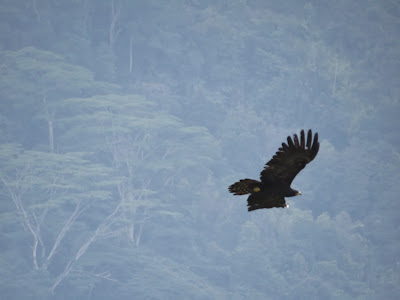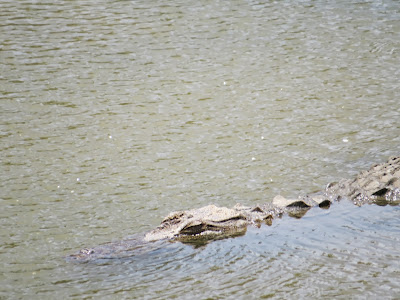Baya Weaver is a Weaver Bird found across in the Indian Sub Continent and Southeast Asia. These nest colonies are usually found on thorny trees or palm fronds and the nests are often built near water or hanging over water where predators cant reach easily. A male bird is known to make 500 trips to complete a nest.
These sparrow size bird is 15 cm in length.They have a stout conical bill and a short square tail. Baya Weavers are social and unreserved birds. They forged in flocks for seeds, both on the plant and on the ground. They are known to glean paddy and other grain in harvested fields, and occasionally damage ripening crops and are therefore sometimes considered as pests.
Captured in Wasgamuwa National Park.
Tuesday, December 24, 2013
Tuesday, December 10, 2013
Tuesday, December 3, 2013
The Hoopoe
The Hoopoe is a colorful bird that is found across Afro-Eurasia. Hoopoe is a medium sized bird 44-48 Centimeters in length and weighing up to 46-90 g. Hoopoe has broad and rounded wings capable of strong flight. Hoopoe is widespread in Europe, Asia and North Africa. This bird is known as a migrant bird in Sri Lanka.
Hoopoe mainly feeds on insects, small reptiles and frogs.
Captured in Yala National Park
Hoopoe mainly feeds on insects, small reptiles and frogs.
Captured in Yala National Park
Thursday, November 28, 2013
Orange Breasted Green Pigeon
Orange Breasted Green Pigeon is a Pigeon found across tropical Asia south of the Himalaya across the Indian Sub Continent and extending into parts of Southeast Asia. Orange Breasted Green Pigeons mainly feeds on small fruits and seeds.
Orange Breasted Green Pigeons usually occur in Singly or in small groups and pairs. It's flight is fast and direct, with the regular beats and occasional sharp flick of the wings are which are characteristics of pigeon in general.
Orange Breasted Green Pigeon is a resident breeder in Sri Lanka and mainly breed from December to May.
Captured in Lunugamwehera National Park
Orange Breasted Green Pigeons usually occur in Singly or in small groups and pairs. It's flight is fast and direct, with the regular beats and occasional sharp flick of the wings are which are characteristics of pigeon in general.
Orange Breasted Green Pigeon is a resident breeder in Sri Lanka and mainly breed from December to May.
Captured in Lunugamwehera National Park
Wednesday, November 20, 2013
Sunday, November 17, 2013
Black Eagle - One of the Biggest Eagles in Sri Lanka
Black Eagle is a large raptor at about 75 - 85 centimeters in length and is a bird of pray. They soar over forests in hilly regions in tropical Asia and hunt for mammals and birds. Black Eagle is a resident breeder in Sri Lanka and India.
Adult Black Eagle's plumage is all black with yellow bill and feet. Black Eagle is known as nest predator and slow flight over the forest canopy. Black Eagle is easily identified by their slow flight and widely spread long primary "Fingers".
Captured in Bible Rock - Mawanella.
Adult Black Eagle's plumage is all black with yellow bill and feet. Black Eagle is known as nest predator and slow flight over the forest canopy. Black Eagle is easily identified by their slow flight and widely spread long primary "Fingers".
Captured in Bible Rock - Mawanella.
Thursday, November 14, 2013
Black Capped Oriole/ Black-hooded Oriole
Black Capped Oriole is a whistling/Singing bird which belongs to Oriole family. This bird is a resident breeder in tropical southern Asia from India and Sri Lanka east to Indonesia.
This bird manly feeds on fruits and insets. This bird spend their time mostly on tree canopies. Orioles can be shy,and even the male may be difficult to spot in the dappled yellow because of the green leafs of the canopy.
This bird manly feeds on fruits and insets. This bird spend their time mostly on tree canopies. Orioles can be shy,and even the male may be difficult to spot in the dappled yellow because of the green leafs of the canopy.
Tuesday, November 5, 2013
Sri Lankan Jackal - Canis aureus naria (Endemic)
Sri Lankan Jackal is a subspecies of Golden Jackal native to Sri Lanka. It Occurs all of Sri Lanka. It is classed by the IUCN as "Least Concern" due to its widespread range in areas with optimum food and shelter. Sri Lankan Jackal is highly adaptable, being able to feed many foodstuffs.
Sri Lankan Jackal is at about 67 -74 centimeters in length and 5.8 to 6 kg in weight. The winter coat is shorter and smoother ( compared to Indian Jackal). The coat is darker on the back, being black and speckled with white.
Sri Lankan jackal rarely hunts in groups. Sri Lankan Jackal family includes 8-12 jackals. Sri Lankan Jackal is known to kill animals up to three times it's own weight. Upon capturing large pray, the Sri Lankan jackal makes no attempt to kill its pray, but rips open its belly and eats the entrails. Small pray is typically killed by shaking, though snakes may be eaten alive from the tail end.
Captured in Kumana & Yala National Park.
Sri Lankan Jackal is at about 67 -74 centimeters in length and 5.8 to 6 kg in weight. The winter coat is shorter and smoother ( compared to Indian Jackal). The coat is darker on the back, being black and speckled with white.
Sri Lankan jackal rarely hunts in groups. Sri Lankan Jackal family includes 8-12 jackals. Sri Lankan Jackal is known to kill animals up to three times it's own weight. Upon capturing large pray, the Sri Lankan jackal makes no attempt to kill its pray, but rips open its belly and eats the entrails. Small pray is typically killed by shaking, though snakes may be eaten alive from the tail end.
Captured in Kumana & Yala National Park.
Monday, November 4, 2013
Sri Lanka - Land With Rich Biodiversity
Wild life of Sri Lanka comprises to its flora and fauna and
their natural habitats. As a country with high rate of biological endemism (16%
of fauna and 23% of flowering plants are endemic) in the world even though its
relatively small. Sri Lanka is ranked among world’s top twenty five biodiversity
hot spots.
Sri Lanka is ranked one of the best places for watch
Elephants, Leopards, Dolphins & Blue whales.
The mountains and the southwest part of the country known as
the “Wet Zone “ with an average rainfall figure of 2500mm. Most
of the southeast, east, and northern part of the country belong to “Dry Zone”
with an average rainfall figure of 1200 – 1900mm.
Fauna.
Mammals
Sri Lanka is home to roughly 91 species of mammals, 41 of
which are endangered. Out of this 91 species 16 are endemic and 14 are
endangered including Sloth Bear, Sri Lankan Leopard, Elephant and Sambar. Sri Lanka’s surrounding waters home to 26
species of sea mammals.
Reptiles.
In Sri Lanka currently 171 reptile species have recorded.
Out of this 101 are endemic species and 56 are endangered including Mugger
Crocodile and Saltwater Crocodile.
Amphibians.
Sri Lanka has one of the richest diversity of amphibians in
the world, comprising over 106 species (90 endemic) and has been claimed to
have the highest amphibian density in the world. Out of 106 species 52 are
endangered.
Birds.
Sri Lanka is home to 482 bird species which includes
endemic, resident and migrant birds. Out of 482 there are 33 endemic bird
species in Sri Lanka.
Fish
In Sri Lanka there are 82 freshwater fish species have
recorded, of which 28 are threatened.
Butterflies.
Sri Lanka is home to 245 butterfly species, of which 24 are
endemic species.
Scorpions.
There are 18 species of scorpions which are found in Sri
Lanka. Out of this 18 species 7 are endemic to Sri Lanka.
Flora.
There are 3,210 flowering
plants fitting to 1,052 classes. 916 species and 18 classes are
endemic to the island. Additionally, all but one of the island’s more than 55 tropical low land rain forest trees are confined to Sri Lanka. Wet zone which
accounts for only a quarter of Sri Lanka’s land area, harbors 88 percent of the
flowering plants, and 95 percent of country's flowering plant endemics. The
natural forests of Sri Lanka are categorized into eight types.
Crocodiles in Sri Lanka
The family Crocodylidae
is generally represented by three categories namely
In Sri Lanka these two species have found in dry
climate forests like Kumana, Wasgamuwa, Yala & Wilpattu, Reservoirs, River
banks and tanks.
Mugger or Marsh
crocodile is the most widely spread crocodile in Sri Lanka. Mugger Crocodiles
have reported from upcountry reservoirs along the Mahaweli River.
Saltwater or
Estuarine crocodile is the largest reptile living and most widely spread
crocodile specie in the world. But this specie is recorded only in wetlands and
river channels in Sri Lanka. An adult crocodile is around 6 meters in length
and 1000kg in weight. It can swim large distances in open sea and rivers as
well. Both species are threatened due to habitat demolition and pouching.
Here are some photos from Kumana & Wasgamuwa National Parks.....
Sunday, November 3, 2013
Sri Lankan Sloth Bear - Endangered Specie in Sri Lanka
Sri Lankan Sloth Bear is a sub specie of Sloth Bear. You can spot the Sloth Bear mainly in lowland dry forests like Wasgamuwa, Kumana, Yala & Wilpattu and other national parks in Sri Lanka. Sri Lankan Sloth Bear feeds on every thing that's why this animal is known as a "Omnivore". It feeds on nuts, berries, and roots as well as flesh and meet. ( Very Rarely feed on flesh & meet)
Sri Lankan Sloth bears are solid with a long and hairy black coat. Fully grown Sri Lankan Sloth bear is around 6 feet in length and 130 -145 kg in weight. This specie is a highly endangered animal in Sri Lanka because demolition of dry climate forests in Sri Lanka. Current Sloth Bear population is less than 1000. Sri Lankan Sloth Bear is highly dependent on natural resources for its foods.
Sri Lankan Sloth bears are solid with a long and hairy black coat. Fully grown Sri Lankan Sloth bear is around 6 feet in length and 130 -145 kg in weight. This specie is a highly endangered animal in Sri Lanka because demolition of dry climate forests in Sri Lanka. Current Sloth Bear population is less than 1000. Sri Lankan Sloth Bear is highly dependent on natural resources for its foods.
Friday, November 1, 2013
Common Iora - Singing Bird
Common Iora is a small passerine bird found across the tropical Indian sub continent. These birds can easily spot with their bright colors and loud whistles. Common Ioras search in trees in small groups, gathering among the branches for insects.
During the breeding season, the males performs an acrobatic courtship (dating) display.
Captured in Wasgmauwa National Park
In the first two images you can see the female Common Iora...
During the breeding season, the males performs an acrobatic courtship (dating) display.
Captured in Wasgmauwa National Park
In the first two images you can see the female Common Iora...
Subscribe to:
Comments (Atom)




















































